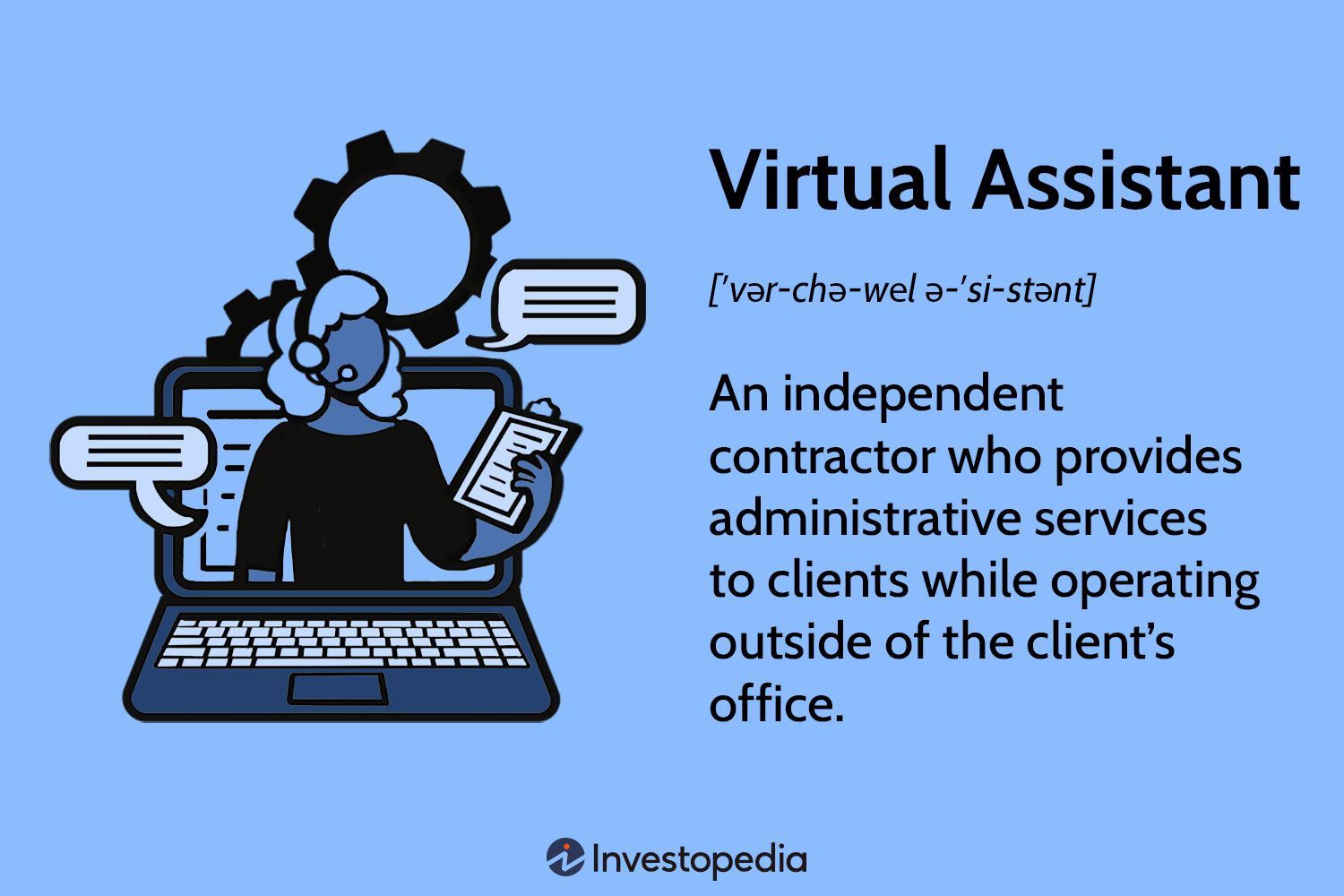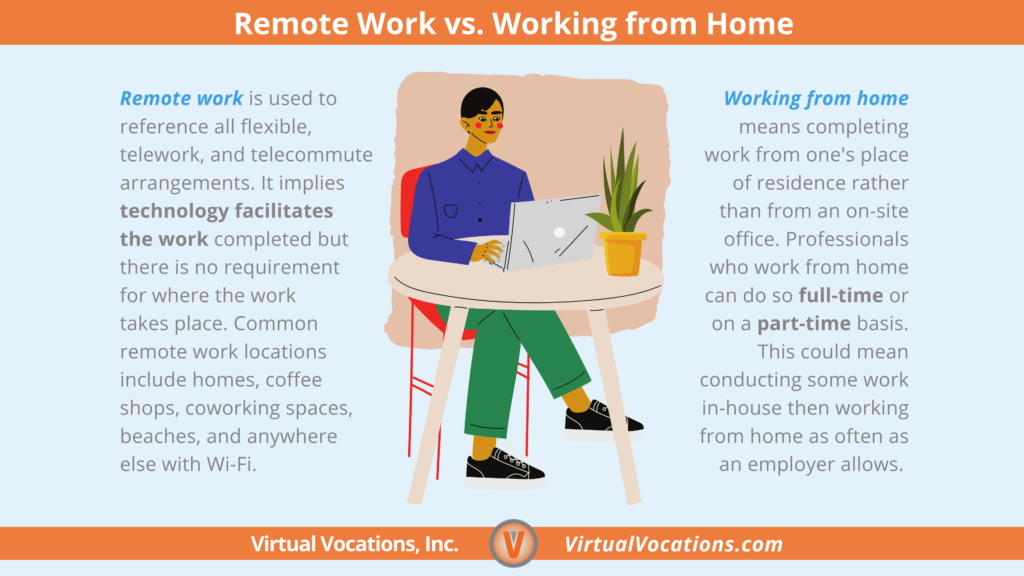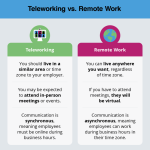A remote position refers to working from a location outside the office, while a virtual position implies working in a completely digital environment without a physical office. Remote positions can still require physical meetings, while virtual positions do not.
As technology continues to advance, the traditional concept of work has been challenged, and remote and virtual positions have emerged as a response to this shift. Remote positions are becoming increasingly common as they offer flexibility to employees, allowing them to work from anywhere in the world.
In contrast, virtual positions are entirely digital and do not require a physical office location. Both remote and virtual positions have their unique benefits, and companies are adopting these models to attract a wider pool of talent. We will explore the differences between remote and virtual positions in detail.
Remote Versus Virtual: Clearing The Confusion
Remote work and virtual positions are terms often used interchangeably, leading to confusion. It’s important to understand the key differences between the two to effectively navigate the modern work landscape. Let’s delve into the distinctions between remote and virtual positions to clear the confusion.
Defining Remote Work
Remote work refers to a working arrangement where employees are not physically present in a traditional office setting. They can work from home, a co-working space, or any location outside of the employer’s office. This setup allows for flexibility in terms of working hours and location, enabling individuals to balance work and personal life more effectively.
Characteristics Of Virtual Positions
Virtual positions, on the other hand, involve a fully digital work environment. Employees in virtual positions primarily interact and collaborate through online platforms and tools. This includes virtual meetings, digital project management systems, and cloud-based communication channels. Virtual positions often entail a higher level of reliance on technology and digital communication tools compared to remote work.
Historical Evolution Of Work Environments
From Traditional Offices To Digital Nomadism
Work environments have undergone a remarkable transformation over the years, evolving from the traditional office setup to the increasingly popular concept of digital nomadism. In the past, employees were typically confined to a physical office space, commuting daily to their workplace to carry out their tasks. However, advancements in technology have revolutionized the way we work, giving rise to the flexibility of remote and virtual positions.
The Rise Of Virtual Companies
With the rise of virtual companies, geographic boundaries have become increasingly irrelevant in the world of work. Virtual companies leverage digital tools and communication platforms to facilitate collaboration and productivity, allowing employees to work from anywhere with an internet connection. This shift has not only empowered individuals to achieve a better work-life balance but has also enabled companies to tap into a global talent pool, fostering diversity and innovation.
Key Components Of Remote Work
Remote work has become increasingly popular in recent years, offering employees the flexibility to work from anywhere. Let’s delve into the key components of remote work.
Physical Location Independence
Remote positions allow employees to work from any location with an internet connection. This flexibility promotes a better work-life balance.
Technological Tools For Remote Employees
- Remote employees rely on technological tools such as video conferencing and project management software.
- These tools facilitate seamless communication and collaboration among remote teams.
- Cloud-based storage solutions enable easy access to documents from anywhere.

Credit: www.investopedia.com
Virtual Positions Unpacked
Virtual positions are a growing trend in today’s workforce, offering flexibility and opportunities for remote work from any location. Let’s unpack the concept of virtual positions and explore the key elements that differentiate them from traditional remote positions.
The Virtual Office Space
A virtual office space is a digital environment where employees can carry out their work tasks using various online tools and platforms. Unlike a physical office, a virtual office space allows individuals to connect and collaborate from different locations, leveraging technology to stay connected and productive.
Collaboration In A Virtual Setting
Collaboration in a virtual setting involves utilizing communication tools such as video conferencing, instant messaging, and project management platforms to work together seamlessly. Virtual teams can effectively collaborate on projects, share ideas, and provide feedback, fostering a sense of connection and teamwork despite physical distance.
Comparative Analysis: Remote And Virtual
Communication Styles
Remote positions often rely on written communication through emails, messaging apps, and video calls. This form of communication allows for clear documentation and asynchronous communication, as team members can respond at their convenience. In contrast, virtual positions emphasize real-time communication through virtual meetings and instant messaging, fostering immediate feedback and collaboration.
Team Dynamics And Management
In remote positions, team dynamics may be more independent, with individuals managing their own schedules and tasks. Virtual positions, on the other hand, often require a higher level of coordination and management to ensure seamless collaboration among team members. Virtual team management involves utilizing virtual project management tools and setting clear expectations for team members.

Credit: www.flexjobs.com
Impact On Work-life Balance
Remote positions refer to working from a location outside the office, while virtual positions are entirely online. The difference between the two can have a significant impact on work-life balance, as remote work may still require commuting and virtual work may blur the lines between work and personal life.
Flexibility And Personal Time Management
Remote positions offer flexibility in work hours, allowing individuals to manage personal commitments efficiently.
Challenges Of Overlapping Boundaries
Virtual positions may lead to overlapping boundaries between work and personal life, causing difficulty in disconnecting.
Technological Infrastructure
When it comes to the technological infrastructure of remote and virtual positions, the tools and systems in place play a crucial role in ensuring the smooth functioning of teams and workspaces. Let’s take a closer look at the specific software, platforms, and the potential impact of virtual reality on the future of virtual workspaces.
Software And Platforms For Remote Teams
Remote teams rely on a variety of software and platforms to facilitate communication, collaboration, and project management. These tools include video conferencing applications such as Zoom and Microsoft Teams, project management software like Asana and Trello, and cloud-based storage solutions such as Google Drive and Dropbox.
Virtual Reality And The Future Of Virtual Workspaces
Virtual reality (VR) has the potential to revolutionize the concept of virtual workspaces by creating immersive environments that simulate physical offices. As VR technology continues to advance, it could offer virtual teams a more interactive and realistic way to collaborate, conduct meetings, and engage in virtual team-building activities.

Credit: www.linkedin.com
Legal And Hr Considerations
In considering the legal and HR aspects of remote and virtual positions, it is crucial to understand the contractual differences, tax implications, and jurisdictional challenges that come into play. These factors have a significant impact on the legal and HR considerations when hiring and managing remote or virtual employees.
Contractual Differences
When hiring remote employees, it is essential to have clear and comprehensive employment contracts that outline the terms of employment, working hours, benefits, and termination clauses. Virtual positions may require specific provisions related to the use of virtual workspace and technology. Both types of positions should also address data security and confidentiality concerns.
Tax Implications And Jurisdictional Challenges
Remote and virtual positions can create tax implications and jurisdictional challenges for employers, especially when employees are located in different states or countries. It is important to consider the potential impact on payroll taxes, income taxes, and compliance with local labor laws. Employers must navigate these complexities to ensure compliance with applicable tax regulations and labor laws.
Case Studies: Companies Embracing Remote And Virtual Work
Remote and virtual work have become essential components of modern business operations. Let’s explore how companies are successfully implementing these models.
Success Stories Of Remote Work Models
1. Company A – Increased productivity by 30% after transitioning to a fully remote setup.
2. Company B – Saved $500,000 annually in office rental costs by adopting a remote work policy.
Innovative Virtual Companies
1. Company X – Operates entirely in the virtual space, utilizing advanced collaboration tools for seamless communication.
2. Company Y – Achieved a global reach by embracing a virtual work environment, attracting top talent from around the world.
Future Trends In Remote And Virtual Employment
Predictions For The Post-pandemic Workforce
As we look ahead, the post-pandemic workforce is expected to embrace flexible working arrangements with a significant rise in remote and virtual positions.
Emerging Technologies Shaping Work
Technologies such as AI and collaboration tools will continue to revolutionize the way we work, enabling seamless communication and productivity.
Frequently Asked Questions
What Is The Meaning Of Virtual And Remote?
Virtual means something that is not physically present but exists in a digital or simulated environment. Remote means something that is situated far away and can be accessed or controlled from a distance.
What Does “virtual Job” Mean?
A virtual job is a position that can be done remotely, typically from home or any location with internet access.
What Is A Remote And Virtual Team?
A remote team works from different locations, while a virtual team operates entirely online.
What Does Remote Position Mean?
A remote position allows you to work from a location other than the company’s office.
Conclusion
Understanding the difference between remote and virtual positions is crucial. Remote work involves off-site tasks, while virtual positions are entirely online-based. Each has unique benefits and challenges, so choose the one that aligns best with your needs and preferences. Embrace the flexibility of modern work environments!



